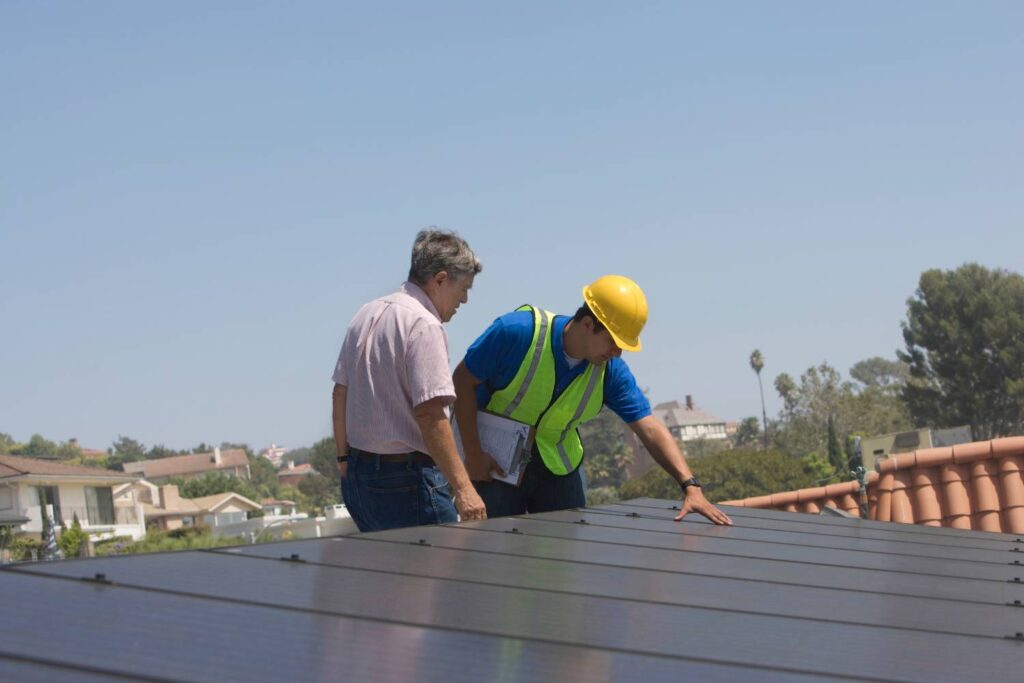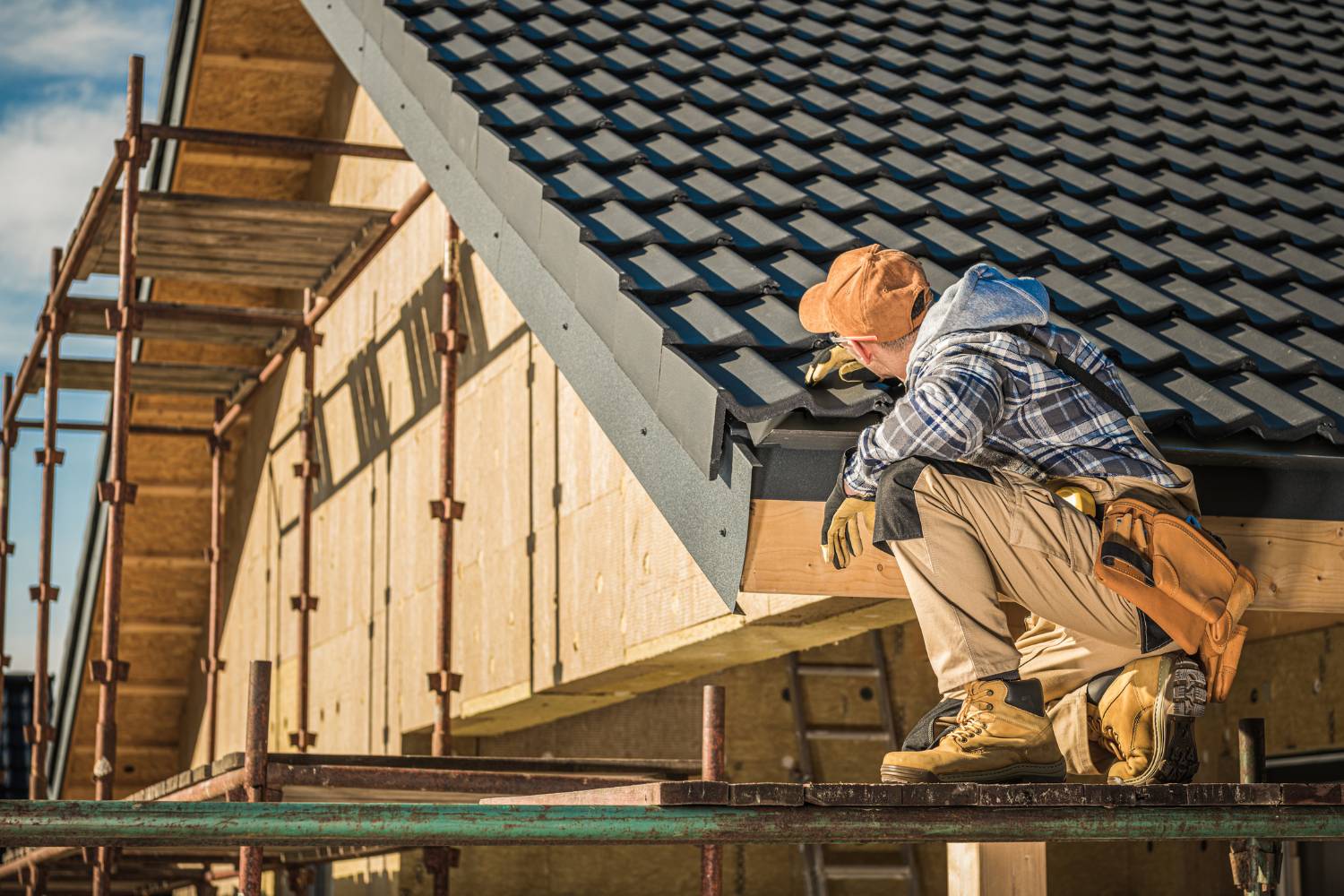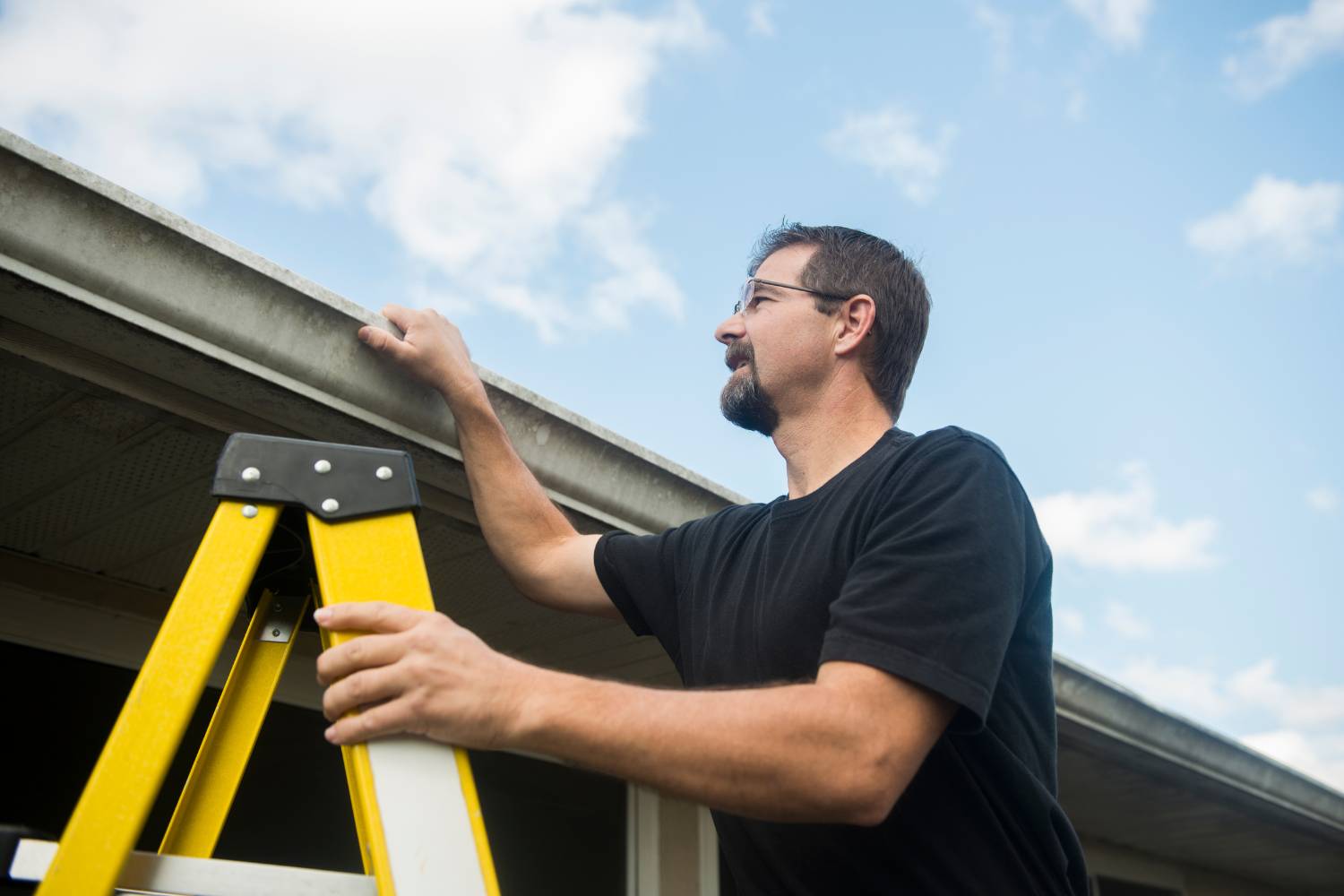Inspecting your roof is an essential task to ensure the longevity and safety of your home. Regular inspections help you identify potential problems early, preventing costly repairs and extending the life of your roof. However, it's crucial to conduct these inspections safely and effectively.
This guide will walk you through the steps to inspect your roof for leaks, from choosing the right ladder to inspecting both the exterior and interior of your roof. Whether you’re a DIY enthusiast or prefer to hire a professional, understanding these steps can help you maintain a leak-free roof and protect your home.
How To Safely Inspect Your Roof
Inspecting your roof is an essential maintenance task that helps prevent costly repairs and ensures the longevity of your home. However, roof inspections can be dangerous if not done correctly. Here’s a comprehensive guide on how to safely inspect your roof.
Choose the Right Ladder
- Material: Opt for fibreglass or wood ladders near power sources to avoid electrical hazards.
- Length: Ensure the ladder is long enough but not excessively so. Follow the InterNACHI guidelines on ladder length.
- Duty Rating: Check the ladder’s duty rating to ensure it can support your weight, plus any tools and equipment.
- Condition: Inspect the ladder for any damage or wear. Make sure all parts are functioning properly.
Wear Appropriate Footwear
- Choose shoes with flat, heavy soles for better traction and to prevent foot fatigue.
- Avoid athletic shoes with cleats that can damage shingles.
- Ensure the soles are clean to maximise grip.
Proper Ladder Placement
- Set the ladder on firm, level ground away from obstructions.
- Use the four-to-one rule: for every four feet of ladder height, place the base one foot away from the structure.
- Ensure all locks and braces are fully engaged.
Inspect the Roof Exterior
- Look for missing, broken, or damaged shingles or tiles.
- Check for gaps around chimneys, vents, and skylights.
- Inspect flashing for bends, holes, or rust.
- Ensure gutters are clear of debris to prevent water backup.
Inspect the Attic
- Use a flashlight to check for signs of moisture, darkened wood, or mould.
- Look for penetration points like vents or chimneys.
- Identify any daylight shining through, which could indicate holes.
Safe Climbing Practices
- Climb slowly and deliberately, avoiding sudden movements.
- Maintain three points of contact at all times.
- Use a safety harness if necessary.
If It's Too Dangerous, Skip It
- Wet, icy, or mossy roofs are particularly hazardous.
- Consider using binoculars, a pole camera, or a drone for safer inspection.
- Hire a professional if the inspection appears too risky.
Preventative Measures
- Clean gutters and downspouts regularly.
- Trim overhanging branches to prevent damage.
- Schedule routine professional inspections.
- Promptly replace any missing or damaged shingles.
- Address any ponding water issues to ensure proper drainage.
- Regularly check and seal flashings.
- Ensure proper attic insulation and ventilation to prevent ice dams.
What To Do If You Find A Leak On Roofs
Discovering a leak in your roof can be a stressful experience, but taking prompt and appropriate action can minimise damage and repair costs. Here are some steps to follow if you find a leak on your roof, based on insights from various sources.
Identifying the Leak
Visual Inspection
Ceiling Check
Begin by closely inspecting your ceiling for any dark stains, discolouration, or wet spots. These signs indicate moisture penetration, which could be due to a roof leak. Also, look for any sagging areas or bubbling paint, as these are tell-tale signs of water damage.
Attic Examination
Head to your attic with a flashlight. Inspect the insulation for dampness or water stains, which are strong indicators of a leak. Pay particular attention to the rafters and sheathing; look for any signs of water trails or wet spots. If it’s safe, consider inspecting during or right after a rainstorm when leaks are more likely to be visible.
Outside Inspection
Shingle Assessment
From the ground, use binoculars to examine the roof for any damaged, missing, or curled shingles. These are common entry points for water. Note any areas where the shingles appear loose or lifted, as these can be vulnerable spots.
Flashing Inspection
Roof flashing, the metal pieces around chimneys, vents, and valleys, is crucial for preventing leaks. Check these areas for any cracks, corrosion, or missing pieces. Damaged flashing can allow water to seep under the shingles and into your home.
Gutters and Downspouts
Examine your gutters and downspouts for clogs, damage, or signs of overflow. Blocked gutters can cause water to back up and seep under the roofing material, leading to leaks. Ensure they are clear and securely attached to effectively direct water away from your home.
Immediate Actions
Protect Your Belongings
As soon as you notice a roof leak, it's crucial to protect your belongings to prevent damage. Follow these steps:
- Move Furniture and Valuables: Quickly move any furniture, electronics, or valuable items away from the area beneath the leak. This helps to prevent water from causing damage to your possessions.
- Place a Container: Position a container, such as a bucket or large bowl, directly under the leak to catch the dripping water. This simple step can minimise the water damage to your flooring and reduce the risk of slipping on wet surfaces.
Temporary Covering
To mitigate further damage, before a professional can fix the leak, you should cover the affected area. Here’s how to do it:
- Use a Tarp or Plastic Sheeting: Obtain a tarp or a large piece of plastic sheeting to cover the leaking area on your roof. If the leak is indoors and easily accessible, you can also use this material to protect the interior.
- Secure the Covering: Ensure the tarp or plastic is securely fastened. If you are placing it outside on the roof, use roofing nails, heavy-duty tape, or weights to keep it in place. If inside, tape the edges securely to prevent water from seeping through.
- Check for Stability: Make sure the temporary covering is stable and not likely to blow away or move during a storm. Recheck periodically, especially if the weather worsens.
Preventative Measures To Avoid Future Leaks
Roof leaks are a common and frustrating issue that can lead to significant damage and costly repairs. By taking preventative measures, homeowners can protect their roofs and extend their lifespan. Here are key strategies to prevent future leaks based on insights from various expert sources:
Regular Roof Inspections
Regular roof inspections are crucial for maintaining the integrity and longevity of your roof. By identifying issues early, you can prevent minor problems from becoming major, costly repairs. Here’s a detailed look at why and how you should conduct regular roof inspections:
Annual Inspections
Scheduling a professional roof inspection at least once a year is a proactive measure to ensure your roof remains in good condition. A professional roofer will:
- Identify Minor Issues: Detect small problems such as loose or missing shingles, minor leaks, or early signs of wear and tear that you might not notice.
- Prevent Major Repairs: Early detection means that minor issues can be fixed before they escalate into major, more expensive repairs.
- Maintain Warranty: Many roofing warranties require regular inspections and maintenance. Annual inspections help you stay compliant with these requirements, ensuring your warranty remains valid.
Post-Storm Inspections
Severe weather events, such as storms, hail, or heavy winds, can cause significant damage to your roof. Conducting a thorough inspection after these events is essential to:
- Identify Damage Promptly: Look for signs of storm damage, such as broken or missing shingles, dents, cracks, or leaks. Addressing these issues immediately can prevent further damage.
- Prevent Water Damage: Even small leaks can lead to extensive water damage, affecting the structural integrity of your home and leading to issues like mould and mildew.
- Insurance Claims: Timely post-storm inspections are crucial if you need to file an insurance claim for roof damage. Proper documentation and prompt action can facilitate the claims process.
Documentation
Keeping detailed records of all inspections, repairs, and maintenance activities is vital for several reasons:
- Track Roof Condition: Documentation helps you monitor the condition of your roof over time, making it easier to spot patterns and recurring issues.
- Facilitate Repairs: Having a history of past repairs and inspections can assist professionals in understanding your roof's maintenance history, allowing them to provide better service.
- Increase Property Value: Well-documented maintenance records can enhance your property's value by demonstrating that the roof has been properly cared for, which can be a selling point for potential buyers.
Gutter Maintenance
Why is Gutter Maintenance Important?
Proper gutter maintenance is crucial for protecting your roof and home from water damage. Clogged or damaged gutters can lead to a host of issues, including roof leaks, foundation problems, and even landscape erosion. Regular maintenance ensures that your gutters function effectively, directing water away from your home and preventing these costly problems.
Clean Gutters Regularly
One of the most important aspects of gutter maintenance is keeping them clean. Regular cleaning prevents the buildup of leaves, branches, and other debris that can block water flow.
- Frequency: Ideally, gutters should be cleaned at least twice a year, in the spring and autumn. However, if your home is surrounded by trees, more frequent cleaning might be necessary.
- Tools: Use a sturdy ladder, gloves, a garden trowel, and a bucket for debris collection. For a more thorough clean, consider using a garden hose to flush out remaining dirt and small particles.
- Safety: Always ensure your ladder is stable and secure. If possible, have someone assist you by holding the ladder steady.
Proper Drainage
Ensuring that your gutters have proper drainage is essential for maintaining the integrity of your roof and home.
- Check Downspouts: Regularly inspect downspouts to make sure they are not clogged. Use a garden hose to test the flow of water. If the water doesn't flow freely, use a plumber’s snake or a similar tool to remove any blockages.
- Slope and Alignment: Gutters should have a slight slope towards the downspouts to facilitate water flow. Ensure they are properly aligned and not sagging. Adjust hangers or brackets as needed to maintain the correct slope.
- Extend Downspouts: Downspouts should direct water at least 1.8 meters (6 feet) away from your home’s foundation. Use extensions if necessary to achieve this distance, preventing water from pooling near the foundation and causing damage.
Debris Removal
Clean Roof Valleys
Remove debris like leaves and twigs from roof valleys to prevent water from getting trapped and causing leaks.
Roof valleys are critical areas where two roof slopes meet, forming a channel that directs water off the roof. However, these valleys can easily accumulate debris such as leaves, twigs, and dirt, especially if there are overhanging trees nearby.
When debris builds up in these valleys, it can block the flow of water, causing it to pool. Stagnant water can then seep under shingles or tiles, leading to leaks and potentially severe water damage to the roof structure and interior of the home.
To prevent these issues, it is essential to regularly inspect and clean roof valleys. Use a roof rake or a broom to gently remove debris, ensuring the valleys remain clear and functional. For safety, consider using a stable ladder and proper fall protection gear. Alternatively, hiring a professional roofing service for regular maintenance can ensure thorough and safe cleaning.
Tree Trimming
Trim trees near the roof to avoid branches rubbing against shingles and causing damage or providing pathways for animals.
Trees add beauty and shade to a property, but when branches extend too close to the roof, they can cause several problems. Overhanging branches can rub against shingles or tiles, especially during windy conditions, leading to wear and tear. This friction can strip away the protective granules on shingles or crack tiles, reducing the roof’s ability to shed water effectively.
Shingle and Flashing Maintenance
Replace Missing Shingles
Promptly replacing any missing or damaged shingles is crucial for maintaining the integrity of your roof. Shingles play a vital role in protecting your home from the elements, and any gaps can lead to serious issues. Missing shingles can expose the underlying roofing materials to water, which can cause leaks and water damage.
Over time, this can lead to structural damage, mould growth, and increased repair costs. Regularly inspect your roof, especially after severe weather, to identify and replace any missing or damaged shingles promptly. Using high-quality shingles that match the existing ones in size, colour, and material ensures a uniform appearance and effective protection.
Maintain Flashing
Flashing is a critical component of your roof, designed to direct water away from key areas where the roof plane meets a vertical surface, such as around chimneys, vents, skylights, and roof valleys. Properly installed and maintained flashing creates a watertight seal that prevents water from seeping into these vulnerable areas.
Regularly check the flashing for signs of damage, such as cracks, rust, or loose components. Repair or replace damaged flashing to maintain its effectiveness. Ensure that the flashing is securely fastened and that the sealant used around it is in good condition. Neglecting flashing maintenance can result in leaks that compromise the roof structure and interior of your home, leading to costly repairs.
Conclusion
Regular roof inspections are a crucial part of home maintenance, ensuring your roof remains leak-free and in good condition. By following the steps outlined in this guide, you can safely inspect your roof, identify potential issues early, and take preventative measures to avoid costly repairs.
Remember, if at any point the inspection seems too dangerous, it's best to hire a professional. Regular maintenance, proper gutter care, and timely repairs can significantly extend the life of your roof and protect your home from water damage. Stay proactive, and your roof will continue to provide reliable protection for years to come.
Frequently Asked Questions
To identify common signs of roof leaks, look for water stains on your ceiling or walls, damp spots, and peeling paint. In the attic, check for mould, mildew, and dark spots on the wooden beams or insulation. Outside, inspect for damaged or missing shingles and examine the flashing around vents, chimneys, and skylights.
You will need a flashlight, a pair of binoculars, a ladder, and a camera. Safety gear such as gloves, non-slip shoes, and a harness is also important. If you suspect leaks, having a moisture meter can help identify hidden damp spots.
The best times to inspect your roof are during spring and autumn when the weather is mild. After a heavy rainstorm, it’s also beneficial to check for new leaks or damage. Regular inspections help catch issues before they escalate.
Use a sturdy ladder and ensure it’s on level ground. Avoid walking on the roof if possible; instead, use binoculars to inspect it from the ground. If you must go on the roof, step carefully on the shingles, avoiding weak spots. Hiring a professional can ensure safety and thorough inspection.
If you find a leak, mark the area and document it with photos. Temporarily patch small leaks with roofing tape or sealant. For extensive damage, contact a professional roofer immediately to prevent further water damage. Regular maintenance and timely repairs can extend the life of your roof.


